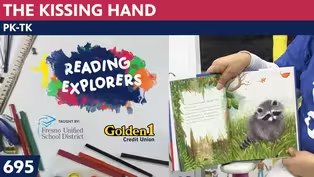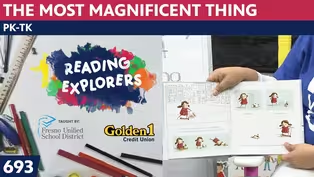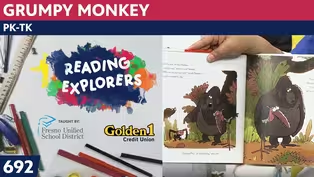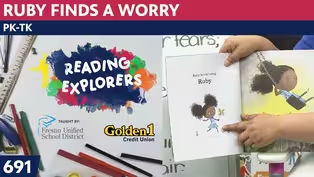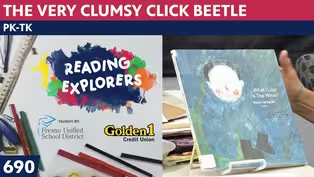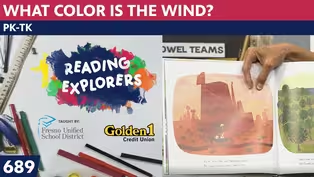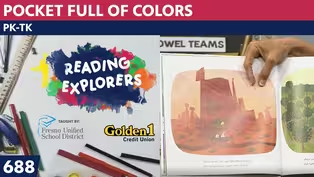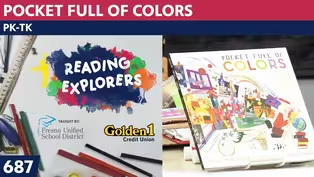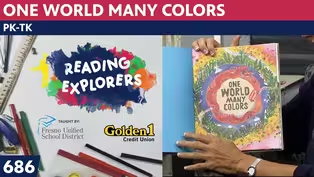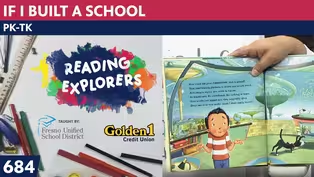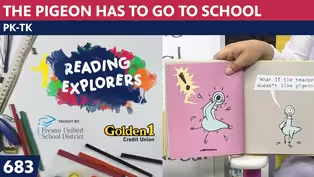
TK-315: Gustav Klimt
Season 3 Episode 66 | 14m 15sVideo has Closed Captions
Join Mrs. Readwright at Camp Discovery!
Transitional Kindergarten teacher, Mrs. Readwright, welcomes students back to Camp Discovery, a fun learning space packed with reading adventures & fun games!
Problems playing video? | Closed Captioning Feedback
Problems playing video? | Closed Captioning Feedback
Reading Explorers is a local public television program presented by Valley PBS

TK-315: Gustav Klimt
Season 3 Episode 66 | 14m 15sVideo has Closed Captions
Transitional Kindergarten teacher, Mrs. Readwright, welcomes students back to Camp Discovery, a fun learning space packed with reading adventures & fun games!
Problems playing video? | Closed Captioning Feedback
How to Watch Reading Explorers
Reading Explorers is available to stream on pbs.org and the free PBS App, available on iPhone, Apple TV, Android TV, Android smartphones, Amazon Fire TV, Amazon Fire Tablet, Roku, Samsung Smart TV, and Vizio.
Providing Support for PBS.org
Learn Moreabout PBS online sponsorshipMore from This Collection
Valley PBS and Fresno Unified School District have partnered with Golden 1 Credit Union to create Reading Explorers Lessons for grades Pre-Kindergarten through Third grade. The daily lessons will be taught by Fresno Unified School District teachers and are created to help students practice their reading skills and reinforce lessons during distance learning.
Video has Closed Captions
Valley PBS presents Reading Explorers Lessons for Pre-Kindergarten and TK. (26m 27s)
PK-TK-693-The Most Magnificent Thing
Video has Closed Captions
Valley PBS presents Reading Explorers Lessons for Pre-Kindergarten and TK. (26m 26s)
Video has Closed Captions
Valley PBS presents Reading Explorers Lessons for Pre-Kindergarten and TK. (26m 28s)
Video has Closed Captions
Valley PBS presents Reading Explorers Lessons for Pre-Kindergarten and TK. (26m 28s)
PK-TK-690: The Very Clumsy Click Beetle
Video has Closed Captions
Valley PBS presents Reading Explorers Lessons for Pre-Kindergarten and TK. (26m 22s)
PK-TK-689: What Color is the Wind?
Video has Closed Captions
Valley PBS presents Reading Explorers Lessons for Pre-Kindergarten and TK. (26m 21s)
PK-TK-688: Pocket Full of Colors
Video has Closed Captions
Valley PBS presents Reading Explorers Lessons for Pre-Kindergarten and TK. (25m 58s)
PK-TK-687: Dancing Through Fields of Colors
Video has Closed Captions
Valley PBS presents Reading Explorers Lessons for Pre-Kindergarten and TK. (26m 20s)
PK-TK-686: One World Many Colors
Video has Closed Captions
Valley PBS presents Reading Explorers Lessons for Pre-Kindergarten and TK. (27m 13s)
PK-TK-685: School is Wherever I am
Video has Closed Captions
Valley PBS presents Reading Explorers Lessons for Pre-Kindergarten and TK. (26m 32s)
PK-TK-684: If I Built a School
Video has Closed Captions
Valley PBS presents Reading Explorers Lessons for Pre-Kindergarten and TK. (26m 21s)
PK-TK-683: The Pigeon Has to Go to School
Video has Closed Captions
Valley PBS presents Reading Explorers Lessons for Pre-Kindergarten and TK. (26m 22s)
Providing Support for PBS.org
Learn Moreabout PBS online sponsorship(upbeat music) ♪ Good morning to a brand new day ♪ ♪ Time to learn and games to play ♪ ♪ Learning things is so much fun ♪ ♪ Learning is good for everyone ♪ (gentle music) - Hello, early learners.
Welcome back to the art room.
You know this week we've been studying different artists and how they might have painted a snowman.
We're using the book by Amy and Greg Newbold as our inspiration.
It's the book called 'If Picasso Painted a Snowman.'
and we have been doing a different artist each day and today we are studying Gustav Klimt.
And remember Gustav, he was born in Austria and he was painting theaters.
He painted the ceilings of theaters with his brother and then he started doing all kinds of art that made him a lot of money.
And he used gold paint in almost all of his paintings which is something when you think Oh, that painting has gold, I wonder if it's Gustav Klimt.
And when you say that to other grownups they think, wait how do you know about Gustav Klimt?
But let's start our day off with our hello song that we started on Monday and it goes like this.
♪ Hello nice to see you everyone ♪ ♪ Hello nice to see you everyone ♪ ♪ Hello to you ♪ ♪ Hello to you ♪ ♪ Hello to you ♪ ♪ Hello to me ♪ ♪ Hello nice to see you everyone ♪ And I'd like to do my, one, two, say hi to you because our friends at Hamilton, T-K and Mrs Damien's class they have been doing art with me every single day.
And they have been writing to me and I told them I would say hello.
So today my special hello goes out to Emily and Roman.
Now I've said hi to two people each day.
If you haven't had your name called, don't worry because next week I'm going to continue and your names are on here.
You'll see all, they're on here.
Don't worry one bit.
All righty.
Now, if you are sending your art to us or pictures of yourself doing art and sending it to our address here at the studio, we send a thank you.
PBS has bought a bunch of these books and they're sending them off to children who write to us at the studio and include their home address.
So if that's you and you wanna get some mail, send something to us.
Now, today we're going to sing this song, if Gustav Klimt painted a snowman.
♪ If Gustav Klimt painted a snowman ♪ ♪ How would that snowman look ♪ ♪ Would it be like his other work ♪ ♪ Let's check out the book ♪ So in the book I enlarged it so you could see what his picture is like.
Let me put it up next to 'The Kiss.'
'The Kiss' is the picture that we studied when we studied Gustav Klimt.
And here is the one that Greg Newbold made to look like 'The Kiss' by Gustavo Clint.
Two people are hugging but in ours here, I see a third person.
So maybe it is their child.
So you can decide how many snow men you want to have in this big hug.
But you can see it's kind of like a mountain of people, and it looks as if each of them is wearing a quilted outfit.
So here is the biggest figure, I thought it might be the dad.
And here's the medium size figure, I thought it might be the mom and then the littlest figure is in the middle and I thought that might be the baby.
So when we do the work I'm doing my paper in a landscape way, which is horizontal.
So let's take a look.
When I put it on my lap because we're talking about pattern, and I know in our pre-K classes they're doing all kinds of things with pattern this week.
And so I can do a pattern of squares and rectangles.
This is a rectangle that's outlined with a white rectangle next to a tan rectangle.
Over here are things that look like they might be an onion or an eye.
Here there's checkerboards and swirls.
They're all kinds of patterns and if you remember when we were doing our art and using the zentangles that's what we can do.
So I'm going to show you how I'm going to start this.
Let me put my clipboard back here so it's not in our way and get my board and put it on my lap.
I have to look at it when I'm working boys and girls and I'll try to remember to turn it toward you as I'm working, but I want to do it horizontal.
This is vertical when the paper stands up, but when we lay it side to side and the reason I'm doing that is because the one that's in the book really is side by side.
So what I'm going to do is make kind of the mountain shape of the bodies so that I can see how I want to do my quilty pieces.
So I'm gonna start at the bottom and do kind of a lumpy mountain up to the top and I'll show it to you.
I wonder if you can see that print or maybe you know what, even though I don't really want it black I'm going to do that so you can see it.
So I'm gonna outline it so you can see.
I made it kind of a lumpy mountain.
All right, I'm turning it back to me so that I can see.
I'm going to put the big head here for the dad snowman, and I think I'm just gonna make the medium sized one.
So, and if a baby wants to be there maybe I'll put the little baby one over here.
And if I want to make his nose and her nose is hugging and facing him and I think the child will face that way.
And I'll put their two black eyes and two black eyes and two black eyes and two black eyes.
And in the one that we're looking at they have their eyes like they're asleep and hugging.
So if you want to do that, you can put the half moon shape and put little eyelashes down, that shows that they're closing their eyes.
Now, today I'm using my water color pencils.
And remember how they work?
When you color, it just looks like a colored pencil.
And I make little lines so it looks like the carrot is still growing.
Go around the outside of the shape and then I'll use the lighter orange and color it in.
And I don't have to do it very much 'cause once the water touches it, blends it together.
Let me see which brush.
Oh there's my brush I'd picked out for today.
Oh, I probably should have cleaned my water.
That's okay.
So watch.
Once I touch the water to the watercolor brush to the watercolor pencils, excuse me.
It does blend them together.
Now, just like when we did the picture with van Gogh, if you go around the outside of your snow, it looks like it is shaded.
So I'm going to use my colored pencil and now if you don't have the watercolor pencil boys and girls, just use your crayon or your pastels and just make a little bit of a shaded part just near your black line, so that it looks like they're a little rounded piece.
And now I'm going to get my brush and wipe it clean, and I will paint it around the edge and it blends in my colored pencil so it looks like it's shaded in a little bit and it makes it look, instead of just looking like a circle, it's making it into a form.
We remember when we talked about form.
So I know that some of these had black rectangles I'm gonna put the dad's side in some black rectangles.
You can make your design.
So just make a whole row of one shape you'd like to do.
I'm going right next to the edge of that little mountainy the shape of their bodies and I'm then going to color it in.
You can color yours in black or you can use whatever color you've decided to use, but what we want to do is make it look all patterned.
Now this takes a long time.
So you know this project is not going to be finished today.
I'll work on it later on this afternoon, maybe I'll work on it over the weekend and bring it back to show you on Monday.
So you can get an idea of what I did to make it interesting.
Even more so, I'm going to go around each of those with a part of green 'cause I think wouldn't that be pretty?
To have the black rectangles outlined in green and when I water color it, it will make it be a beautiful pattern.
Now, my pattern I'm doing the same thing for everyone 'cause do you remember what the word pattern means?
It's something that repeats itself.
So black with green on the outside, black with green on the outside, black with green on the outside, black with green on the outside.
It just repeats itself over and over and over and that's what I'm doing on this row.
I think I'm going to do some spirals on the other side 'cause I do like the way a spiral looks.
Remember what it is?
You go around until you stop, circle around like you're gonna make a number six and then you stop.
Circle around on number six and stop.
I might start one up this way so my spiral ends in a different place.
You can just twist your paper around a little bit so that you know where you are.
And you think, oh I'll start this one like this.
It starts like a number six.
Maybe I'll go back around this way and this way.
We know that on the edges of Gustav Klimt's work, he put spirals of gold.
So once I do this part and I check and see if I have time to do that, you'll be able to tell how much time I have to do the golden paint.
So you can get an idea how much more I can do.
But on this part, I think I will use my paint brush and go over my green a little bit and show you what it looks like once it gets blended together.
I don't have to blend it totally.
I can just make it go to the edge where it's kind of a light green that way.
Looks pretty good Mrs. Readwright.
I'm gonna get a different brush so that I can make my golden spiral.
I put my gold paint over here on a little lid and I'm going to go around the edge so you can see how pretty it looks with the gold and paintbrush.
Making spirals of gold.
And if you don't have gold paint, do you know what you can use?
You can use a gold crayon.
'Cause gold cram will show up on white paper just fine.
I just like this paint 'cause it didn't cost me very much money and I've used it for about 10 projects and I still have a lot of it.
There it is.
So just so you see an idea of what my outline is going to be all around the edge, I'm going to put gold spirals but let me continue with my pattern inside.
I did green, I did these, I think I'm gonna use some purple and go around them.
Same thing, decide how much you're going to do and get it around the edge.
And if you have water color pencils you know that once you touch the water to it, it blends the colors.
So let me do that so you can see.
In a circle and around.
In a circle and around and I can add more colors as I go along.
It doesn't have to be exactly what it looked like on the other one.
So I'm gonna put a little more purple around here.
And even when my paper's wet I can still do it and blend it in together.
Boys and girls, it's been a terrific week talking about 'If Picasso Painted a Snowman.'
I like it so much that I have five more artists that we're going to study next week.
And if you can remember between now and then you'll bring colored paper on Monday, scraps, background, white papers, scissors and glue.
So let's sing our goodbye.
♪ Good bye ♪ Let me look at the words again.
♪ Goodbye see you next time everyone ♪ ♪ Goodbye see you next time everyone ♪ Goodbye boys and girls, I'll see you on Monday.
Have a terrific weekend.
(upbeat music) ♪ Good morning to a brand new day ♪ ♪ Time to learn and games to play ♪ ♪ Learning things is so much fun ♪ ♪ Learning is good for everyone ♪ (upbeat music)
Support for PBS provided by:
Reading Explorers is a local public television program presented by Valley PBS
